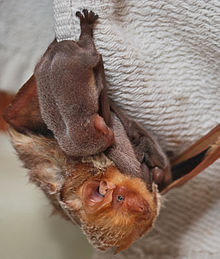Red bat
| Red bat | ||||||||||||
|---|---|---|---|---|---|---|---|---|---|---|---|---|

Red bat ( Lasiurus borealis ) |
||||||||||||
| Systematics | ||||||||||||
|
||||||||||||
| Scientific name | ||||||||||||
| Lasiurus borealis | ||||||||||||
| ( Statius Müller , 1776) |
The red bat ( Lasiurus borealis ) is a species of bat from the smooth-nosed family (Vespertilionidae) that is native to North America.
The generic name Lasiurus is Greek and means "hairy tail". The species name borealis is Latin and means "north".
description
The red bat has an unmistakable brick to rust red coat color with two white spots on the shoulders. The hair is unusually long at 5.8 mm and has a white tip. The underside is slightly paler than the back. The tail membrane is very hairy. The ears are broad and round, and protrude halfway above the muzzle when placed forward. The calcar is twice as long as the foot. The wings are relatively long and narrow, which makes the red bat a fast but not very agile flyer. The total length of the red bat averages 108.9 mm with a forearm length of 40.6 mm and a total weight of 7 to 13 g. The females are slightly larger than the males.
Way of life
The red bat, like most bats, is nocturnal and starts foraging 1–2 hours after sunset. It usually flies in open terrain or above the treetop. It feeds on flying insects such as moths , two-winged birds , hymenoptera, and constant- winged birds , but also prey on insects that live on the ground such as cicadas , beetles, and crickets .
Red bats are usually solitary animals that hang in trees and bushes 1.1–6.2 m above the ground during the day. Sometimes there are groups of up to five animals under a single leaf, although other suitable hanging places would be available. The hanging places are always in the shade, are protected from the sides and are often only open in the lower area.
The red bats belong to the species of bats that migrate in winter and spring , whereby the otherwise solitary animals migrate and hunt in groups. However, some animals remain in the northern regions and spend the winter in hibernation in large groups in well-protected caves. Even outside of hibernation, the animals can go to torpor at temperatures below 20 ° C and reduce their heart rate to less than 16 beats per minute.
Well-known predators include possums , domestic cats , great falcons , merlins , great horned owls and racing cuckoos . In the eastern United States , the blue jay is probably the main predator, targeting young animals in particular.
Reproduction
As with many other bat species in temperate latitudes, the mating of the red bat takes place in autumn. The females store the sperm in their sexual organs through the winter. The ovulation takes place in April and May, after which the egg is fertilized by the stored sperm. After a gestation period of 80 to 90 days, the females give birth to 1–5 naked, hairless young animals with an average weight of only 0.5 g. The average litter size of 2.3–3.2 cubs depending on the area is unusually high for bats. After birth, the young hang with their teeth and thumb claws, as well as with their feet on the mother's fur, but are left behind by the mother in the hanging place while they are looking for food. After 3–4 weeks the young animals open their eyes. The fur is still short at this point, but already relatively dense, and the young now weigh 4–5 g. Older young animals hang in close proximity to the mother during the day and are suckled up to a total of 6 weeks of age. First flight attempts are made at the age of 3 weeks, whereby the boys are independent after 6 weeks.
distribution
The red bat is found in the United States east of the Rocky Mountains to northern Mexico . The species is extinct in Bermuda . The IUCN has rated the species as harmless thanks to its widespread distribution and its occurrence in protected areas.
literature
- KA Shump Jr., AU Shump (1982): Lasiurus borealis. In: Mammalian Species . No. 183, pp. 1-6.
